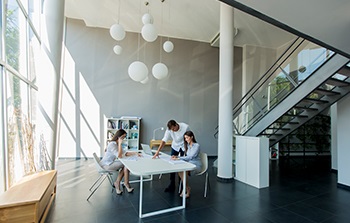As companies and businesses look ahead to a post-COVID year, the question of “what will happen to office space” is continually being asked and researched.
From technology modifications to work from home capabilities, the COVID-19 pandemic has forced each industry to re-evaluate and adjust to what could work for their workforce and employee base.
There is a fine balance between the traditional productive, in-person workforce and the technologically advanced, flexible/work-from-home-setting. Then there’s the in between of both worlds - having some employees at home and some full-time in the office - where both feel the most productive.
On a local level, CBRE | Hubbell Commercial’s quarterly Office Market Survey lends insights into what is being seen in the Greater Des Moines and Central Iowa region as it relates specifically to office space.
In Q4, the Greater Des Moines competitive market vacancy rate hit 14.7 percent, up from 12.4 percent the year prior and leasing activity fell 38 percent year-over-year.
“The deterioration of fundamentals through 2020 was largely underpinned by surges in new supply from user-driven reductions of existing office occupancy just prior to the pandemic,” the survey stated. “These high levels of new supply were met with historically low demand in 2020.”
The market stall is a direct correlation to larger, downtown Des Moines-based companies like Wells Fargo, Nationwide and others having a majority of their workforce primarily work from home and causing a ripple effect into the downtown core. More commercial space is on the market largely due to the “surges in new supply from user-driven reductions of existing office occupancy just prior to the pandemic,” according to the report.
However, in a small bright spot, investment in the Greater Des Moines area continues to be a strong point with a very small decrease during the pandemic.
“Despite the uncertainty in 2020, investment sales volume fell just 9 percent year-over-year to $55.5 million and sales velocity was also steady [in Q4],” stated the survey highlight.
According to the Urban Land Institute's 2021 Emerging Trends in Real Estate, once larger companies welcome employees back to a formal office space, more square footage per employee will be needed. The report also surveyed people on what they believe the post-COVID workplace may look like.
- Overall 92 percent of respondents felt that some changes will be made permanent once the vaccine is widely distributed.
- Nearly 94 percent of respondents said more companies will have to allow a work from home opportunity or a more flexible work schedule
- One study found working from home could save 227 hours of commuting time each year, equaling 28 days of lost productivity to driving.
In a recent interview with Cityview, Korey Birkenholtz, Vice President with CBRE | Hubbell Commercial, reflected on how he’s seen the market and clients adapt to pandemic pressures.
“I find it interesting that the sublease space is 6 percent. I think it will increase. Historically, it is typical for 1-3 percent of available space to be sublease space. More businesses are trying to sublease in order to recoup some money,” said Birkenholtz.
At Hubbell Realty, many employees are being brought back into the office “at their discretion,” says Claire Brehmer, Senior Communications Specialist Hubbell Realty Co. “Many people want to come back to the office, she says. Although a variety of methods were used to communicate with each other and to stay connected in fun ways as well, co-workers still miss each other.”
“It feels like there is a light at the end of the tunnel,” added Birkenholtz.
There’s no surprise that design and technology will be on the forefront of newly created office space and upgrades to the existing buildings if, and when, companies’ welcome employees back to the office. From teleconferencing to video sharing, the pandemic has altered office space and will continue to do so.
“The trend is likely to continue well into 2021.”


ADD A COMMENT